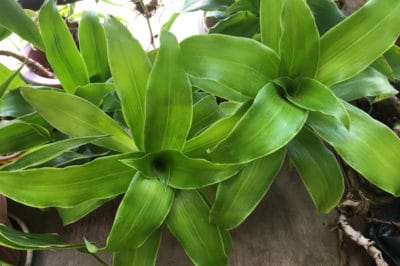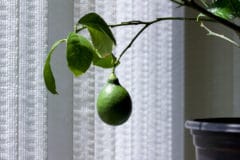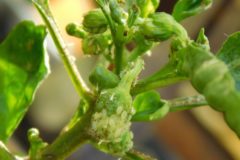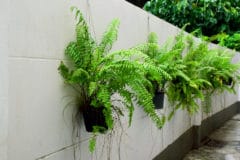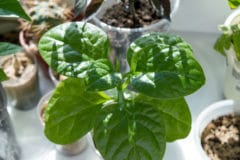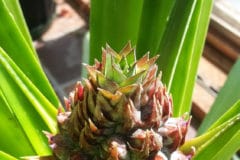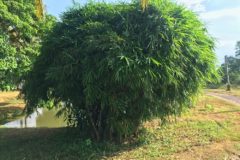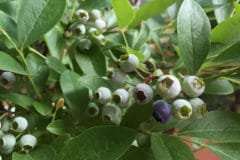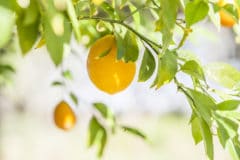Where Can I Grow Callisia Outdoors?
Callisia fragrans can be grown indoors as a houseplant anywhere, but when planted outdoors, it grows best in tropical or sub-tropical climates. Although the plants can withstand light frosts as well as droughts, they do best in USDA Hardiness Zones 10b and 11.
How Much Light Do Callisias Need?
Callisias will grow indoors or outdoors in full to partial sun.
With less sunlight, the leaves remain green, and the plants are more full and compact.
The more sunlight the plants receive, the more color the leaves develop. The leaves can be dark or even black, burgundy to maroon, or orange to apricot. However, too much sun can burn the leaves.
Callisia should receive four to six hours of sunlight or filtered sunlight each day.
When Callisias are Planted Outdoors, What Type of Soil Is Best?
Callisias like rich, loamy, gritty soil with a pH from 6.1 to 7.8. The soil should be well-drained.
What Insects Attack Callisia fragrans?
Callisia has two insect enemies that can attack plants indoors or outdoors – mealybugs and scale.
What Are Mealybugs?
Mealybugs are small, segmented oval insects. Young, yellow-green mealybugs, called nymphs, are active, but the adults seldom move once they attach themselves to a plant and begin feeding on the sap.
Plants infested with large numbers of adult mealybugs can appear to be covered with a cottony white mass on the leaves because adult mealybugs are covered by a white or gray mealy wax.
Like aphids, adult mealybugs secrete honeydew as they feed. Some species of ants feed upon honeydew, and these ants defend the insects that produce honeydew from the natural predators of those insects. So to control mealybugs, you also need to control the ants that they attract.
What Kind of Damage Do Mealybugs Do?
Mealybugs weaken plants by feeding on the sap that carries nourishment throughout the plant. The more mealybugs that feed on a plant, the greater the damage. For this reason, it’s important to bring mealybugs under control as soon as you notice them.
Plants under attack from mealybugs will begin to grow poorly and less quickly. The leaves will begin to curl and turn yellow. Eventually, a mealybug infestation can kill a plant, and young mealybugs will spread the infestation.
How Do I Control Mealybugs?
- For a light infestation on plants growing either indoors or outdoors, test a small area of the plant for leaf burn or phototoxicity with a cotton swab dipped in a solution of rubbing alcohol (isopropyl) with a strength of 70 percent or less two days before treating the infestation. If the plant is not affected, then use cotton swabs to apply the rubbing alcohol directly to the mealybugs. The alcohol dries them out which can kill them.
- Prune infested leaves from plants with light infestations whether they are growing indoors or outdoors.
- Release natural predators like ladybugs and/or lacewings into your garden.
- Dislodge mealybugs with a steady stream of water from a garden hose.
- Spray plants with a commercial insecticidal soap such as Safer’s Insecticidal Soap or a homemade insecticidal soap. Commercial soaps have more predictable results than homemade soaps and also are usually safer for plants.
How Do I Make a Homemade Insecticidal Soap?
A homemade insecticidal soap requires the following ingredients:
- 1 tablespoon of pure dishwashing soap without perfumes, bleach, grease removers, or other additives
- 1 cup of any type of vegetable oil (optional but helps to prevent the spray from drying out or being washed off too quickly)
- 1 cup of water for every 2 teaspoons of a soap and oil mixture or 1 gallon of water for every 1 tablespoon of pure dishwashing liquid
- 1 teaspoon of red pepper or garlic (optional but discourages chewing insects, homemade garlic sprays also act as insecticides but must be diluted to avoid damaging some plants)
Before using any homemade spray, always test it on a small area of one plant a few days before applying it to all of your plants.
If the leaves in the tested area show signs of leaf burn, either don’t use the spray or dilute the solution and test it again.
Keep track of how many parts of water you use versus parts of soap each time you dilute the solution and how your plants respond to each test because you will be able to treat some plants with a stronger solution while others will require a weaker solution. This is especially true for garlic sprays.
Mix only enough for one day at a time whether you are testing your spray or mixing it for a general application.
When you are applying the spray, be certain to wet the insects thoroughly with the spray.
During rainy or hot dry weather, homemade soap sprays may dry off or wash away too quickly to be effective. These conditions can make more frequent applications necessary, but more frequent applications make plants even more vulnerable to phototoxicity or leaf burn.
Because soap sprays leave plants more susceptible to leaf burn, avoid using these sprays on days with bright sun or when temperatures climb above 90°F (32°C).
How Do I Control Ants?
Ants can be trapped and prevented from defending mealybugs by wrapping the stems of your Callisia with sticky tape or nets.
Also, successfully reducing the population of mealybugs through one of the above methods removes the food resource that attracted the ants.
With no honeydew producing insects to protect, the ants have no reason to attack ladybugs, lacewings, or their larva, and these predators can go about their work of preventing any infestations at the egg or larval stage before the adults pests emerge and attract protectors.
What Is Scale?
Scale appears to be a shell-shaped growth on a plant, but it’s actually an insect that, like an adult mealybug, doesn’t move once it has attached itself to a plant and begun to feed on the sap.
Like mealybugs, aphids, and other insects that feed on sap, scale also produce honeydew which draws protective attention from ants.
What Kind of Damage Does Scale Do?
Because both scale and mealybugs feed on sap from the Callisia, they cause the same type of damage – poor growth; yellowed, curling leaves; and death.
How Do I Control Scale?
Some of the means of controlling scale are identical to those for controlling mealybugs:
- Cotton swabs dipped in rubbing alcohol
- Pruning away infested leaves
- Releasing lacewings and ladybugs
- Spraying with insecticidal soaps that dry out and kill the insects
Other means of controlling scale include:
- Picking or rubbing a small infestation off of the leaves by hand. To ensure that the insects die and won’t be crawling up another plant, drop them in a bucket filled with
1 gallon of water and 1 tablespoon of dishwashing liquid. - Dabbing or spraying the scale with neem oil, neem-based leaf shine, or Azamax. Azamax is made from azadirachtin, the main active insecticide contained in neem oil. Unlike many insecticides. Azamax does not harm honeybees and other pollinators and beneficial insects. Further, Azamax attacks insect pests in multiple ways making it extremely unlikely that insects will be able to develop any type of resistance.
- Using oil-based insecticides and horticultural oils that smother even insects with exoskeletons and hard shelled insects like scale.
- Using d-Limonene to kill larva as they hatch if you have spotted eggs on the leaves of your Callisia. However, like soap insecticides, d-Limonene only lasts for short periods of time in an outdoor environment, so repeated, frequent applications will be needed during hatching.
- Using botanical insecticides which are derived from plants that produce natural insecticides. Botanical insecticides act quickly, breakdown quickly when used outdoors, and have fewer negative side effects than chemical pesticides. However, to prevent the development of resistance, these insecticides should be used only as a last resort.
How Do I Start New Callisias?
You can start Callisias from purchased seeds or from bare root tips. The root tips will have aerial roots that will quickly take hold in the soil and begin growing. However, new Callisia are most commonly grown from 2-inch cuttings from mature plants in either the spring or fall.
Make sure the cutting contains a plantlet.
How Do I Start a New Callisia in a Pot?
Start each new Callisia in its own 2-inch to 3-inch pot filled with a rich peat- or soil-based potting mix for flowering plants. Make sure that the pots drain well. Place the pots in a space with bright but filtered sunlight and water them lightly for two to three weeks. After the root system has developed, you can begin treating your new Callisias as mature plants.
How Do I Start New Callisia Outdoors?
You can start new Callisia in pots and then transplant them outdoors in the spring when you would normally repot them. You also can plant the seeds, root tips, or plant cuttings on the ground in a brightly lit but partly shaded area.
Space the plants 4 feet to 6 feet apart to allow room for them to spread.
Water lightly for two to three weeks as you would if starting the plants in pots. Again, after the root systems have been established, you can begin caring for your Callisia as mature plants.
How Do I Care For Callisia That Is Growing Outdoors?
Because Callisias spread, the growth can begin to straggle. Pinch the runners or stolon off frequently to encouraging branching out rather than long, straight runs.
While, as mentioned, Callisia can withstand droughts, water your plants every one to two weeks during periods when you receive no rain. Thoroughly moisten the soil without leaving standing water on the surface. The soil should dry completely between each watering.
Callisia normally reach a height of 6 inches to 12 inches. Watering and fertilizing encourages maximum growth and flowering. You can add an organic fertilizer for flowering plants every 20 to 25 days as you water or side dress your plants by sprinkling an organic slow-release fertilizer for flowering plants around them every three to four months.
Stop watering and fertilizing during the winter months to provide your Callisia with the necessary rest period.
One thing to keep in mind is that, in some areas, Callisia fragrans is considered to be an invasive plant. It can spread aggressively and escape from gardens where it has been planted outdoors.
Florida’s Exotic Pest Plant Council has placed Callisia fragrans on its list of invasive plants, and it also is on the Centre for Agriculture and Bioscience International (CABI) list of invasive species. In the West Indies, Callisia fragrans is threatening to replace the native plants in the Gros Piton World Heritage Site on Saint Lucia.
How Do I Care For Callisia fragrans in a Pot?
During the plant’s growing season – spring, summer, and fall – water your Callisia every two to three days to keep the potting mixture moist without allowing it to become wet. Apply an organic 10-10-10 fertilizer once each month. During their growing season, Callisias prefer temperatures to remain between 61°F and 50°F (16°C – 21°C).
Callisias require a rest period during the winter months. Reduce the temperature to between 50°F to 61°F (10°C to 16°C), stop fertilizing your plants, and water them less frequently, just barely wetting the potting mixture and allowing the top two-thirds of the potting mixture to dry our between each watering.
How Do I Repot Callisia?
Because they grow so quickly, Callisias should be repotted every spring.
Callisia fragrans is a low, sprawling, fast-growing plant, so you may need 5-inch to 6-inch pots or even 1-gallon to 3-gallon containers for larger plants. Be sure that the container provides good drainage.
